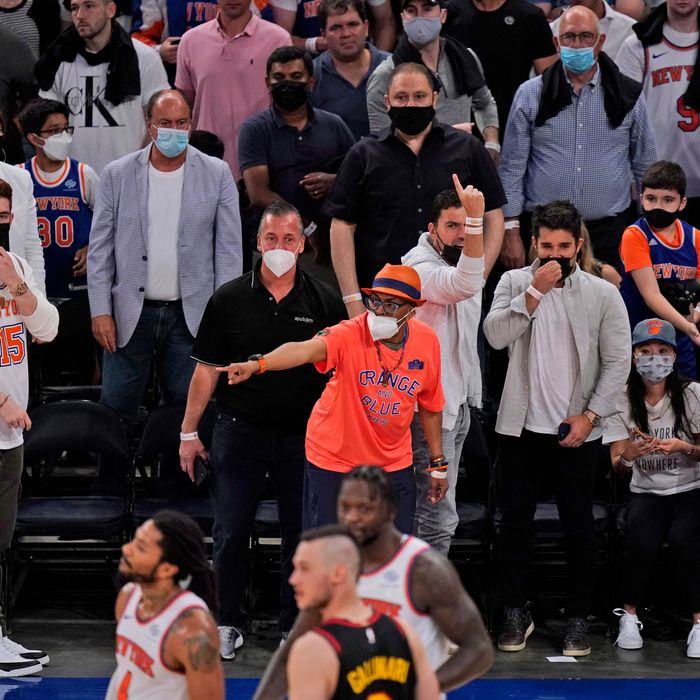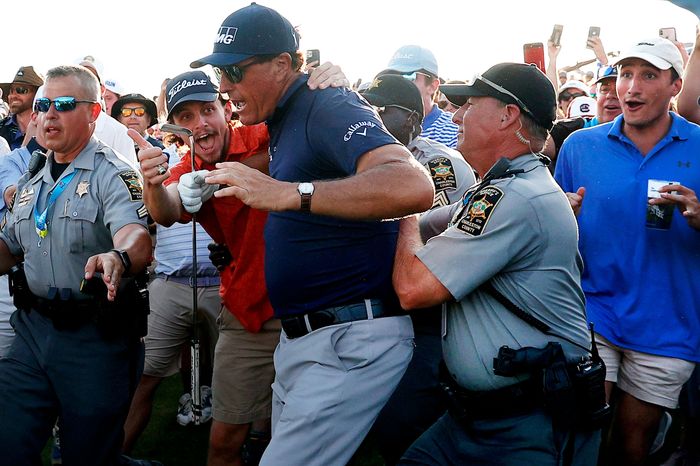
This weekend, Phil Mickelson, probably the second-most popular golfer in the country, won the PGA Championship, becoming the oldest man to ever win a golf major. It was an incredible achievement, and — until Tiger Woods can toss away his crutches — just about the most exciting thing possible in the sport. But you’ll forgive me for focusing less on Mickelson’s accomplishment and more what he had to fight his way through to carry it out. Specifically: Who he had to fight his way through.
Seriously, look at this:
Yes, mask mandates have been lifted, COVID-19 cases are at their lowest levels in ages, and vaccination rates continue to rise. It was nevertheless a bit jarring, after 14 months of hiding my children from their grandparents, to watch the throngs of humanity — well, golf fans — surrounding Mickelson and his entourage in the middle of his round. “Considering where we are in the world right now, it was sort of weird,” said Tim Mickelson, Phil’s brother and caddie. “But it was also pretty darned cool to see.”
And he was right. It was weird and disorienting — but mostly pretty darned cool to see. Sports has proven impressively (or recklessly, depending on your perspective) resilient in continuing to play through the worst pandemic in 100 years, making do with NBA bubbles, pumped-in crowd noise, and cardboard-cutout fans. Beginning with the National Women’s Soccer League last June, the powers that be found a way to plow through the crisis, occasional COVID outbreak be damned. Television contracts were fulfilled, and a little bit of revenue was salvaged. But, now that the pandemic sports era is over (hopefully), we can all admit that what we witnessed wasn’t really sports. Sure, the teams who won championships during the last 14 months can keep their crowns, and the stats all still count. But as grateful as fans may have been to have their favorite players back, the whole enterprise was oddly antiseptic without fans in the stands — almost like some sort of re-enactment of a sporting event than a living, breathing, active one. I went to one of the first baseball games played during the pandemic, in which the only people in attendance were the players, a few media people like myself, and two lonely mascots. All I remember now was the drone of the air conditioner in the press box, which was the only noise in the stadium. I felt like I was watching a game from the inside of a refrigerator.
Fans, it turns out, are what give games life, shape, vigor, context … soul. The 15,000 bonkers fans at Madison Square Garden on Sunday night for the Knicks’ first playoff game in eight years transformed the contest from a normal first-round playoff game into a pulsating expression of desperate Knicks fans’ pent-up yearning. There were moments, particularly after RJ Barrett’s third-quarter dunk, when the noise was so loud and immediate and human that it felt like the crowd was carrying you a few feet above the ground, even if you were just watching from your couch. And then Atlanta’s Trae Young, a glorious New York basketball villain the likes of which city hasn’t seen in 25 years, hit the game-winning basket in the final seconds and pressed his finger to his lips to shush the 15,000 maniacs, most of whom had been screaming, “Fuck Trae Young” since the opening tip. Which was a reminder the silence of fans can be just as loud as their cheers, and just as meaningful.
At its best, a crowd at a sporting event takes on its own collective personality. That personality can be soaring and elevating, and can raise athletes to previously unseen heights. It can also be nasty, raucous, and rude, sometimes dangerously so. But a crowd often acts as a collective One, and after months of Americans not experiencing much of a collective anything, the return of the crowds is breathtakingly refreshing. Hearing that Knicks crowd scream, cheering a wildly fun team that we’ve all been watching in our own isolations for months now, was discombobulating in its power: It was like being plugged back into an electrical grid.
One could still make the case that it’s too early to drop every COVID restriction in sports. But for league executives, the pandemic is essentially over, and the gates have been flung open. Which is to say: Sports, at last, finally feel back. Fifteen thousand New Yorkers are telling an NBA starter to fuck off, golf fans are crawling all over their middle-aged hero, and Fenway Park is going to be sold out and jam packed within the week. There are still countless issues to be resolved throughout the leagues, from the ramifications of the pandemic to social justice protests to player empowerment. But there will be time for all that. Right now, sports are more about the fans than they are about anything else. This was a long time coming. It is unnerving and confusing and awkward, like everything in the world feels right now. It is also absolutely wonderful.
Article From & Read More ( The Extremely Welcome, Slightly Jarring Return of Sports Crowds - New York Magazine )https://ift.tt/3wvGZcy
Sport
Bagikan Berita Ini















0 Response to "The Extremely Welcome, Slightly Jarring Return of Sports Crowds - New York Magazine"
Post a Comment